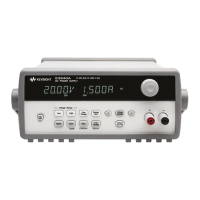Appendix D Output On/Off Synchronization
116 Keysight N6700 User’s Guide
2. Specify which Output Channels will be Synchronized
Select the output channels that will be synchronized.
In the front panel menu, select
.
Check which channels will be coupled.
To remove a channel, uncheck the box.
To specify a channel or
channels:
OUTP:COUP:CHAN 1,2,3,4
3. Specify the Turn-On Delays for each Output Channel
Turn-on delays can be specified for all coupled output channels. Any
delay sequence can be implemented. There are no restrictions on what
the sequence is or what channel comes up first.
For channels 1, 2, 3, and 4,
select
.
Specify the Turn-on delay for
each channel in seconds; then
press Select.
Program a turn-on delays for
channels 1 through 4:
OUTP:DEL:RISE .01,(@1)
OUTP:DEL:RISe .02,(@2)
OUTP:DEL:RISE .03,(@3)
4. Specify the Common Delay Offset
Specifying a common delay offset assures that the user-programmed
turn-on delays will be synchronized to start at the completion of the
common delay offset. Select the delay offset of the slowest power
module in the mainframe and use that as the common delay offset.
In the front panel menu, select
.
The
Max delay offset for this frame
field displays the delay offset of
the slowest power module in the
frame. Enter the delay offset value
of the slowest power module in
the
field in
milliseconds; then press Select.
To query the delay offset of the
slowest power module in the
mainframe (the maximum delay
offset) in seconds:
OUTP:COUP:MAX:DOFF?
To specify the common delay
offset for the mainframe in
seconds:
Note that you can program a common delay that is longer than the
maximum delay offset of the mainframe. You may choose a longer value
to make your program flexible for future configurations that may have
power modules with longer delay offsets. However, if you program a
value that is shorter than the maximum delay offset, you may experience
improper synchronization across all outputs.
There is no need to specify a delay offset when outputs turn off. Outputs
start executing their turn-off delays as soon as an output Off command is
received.

